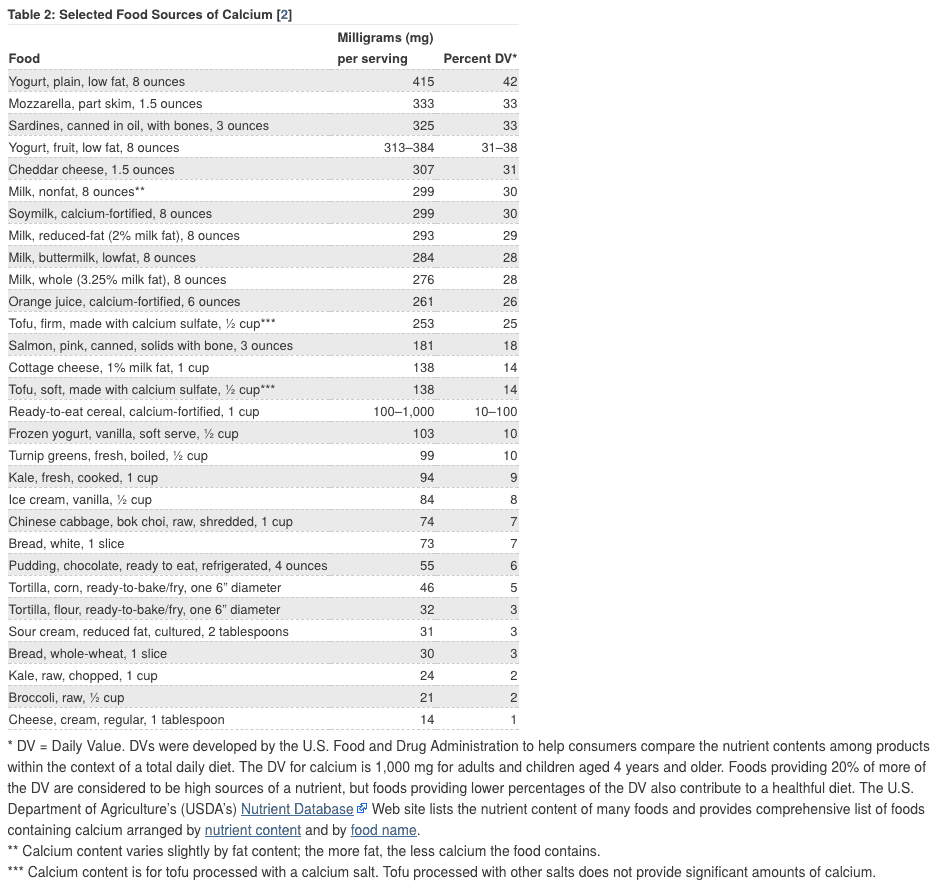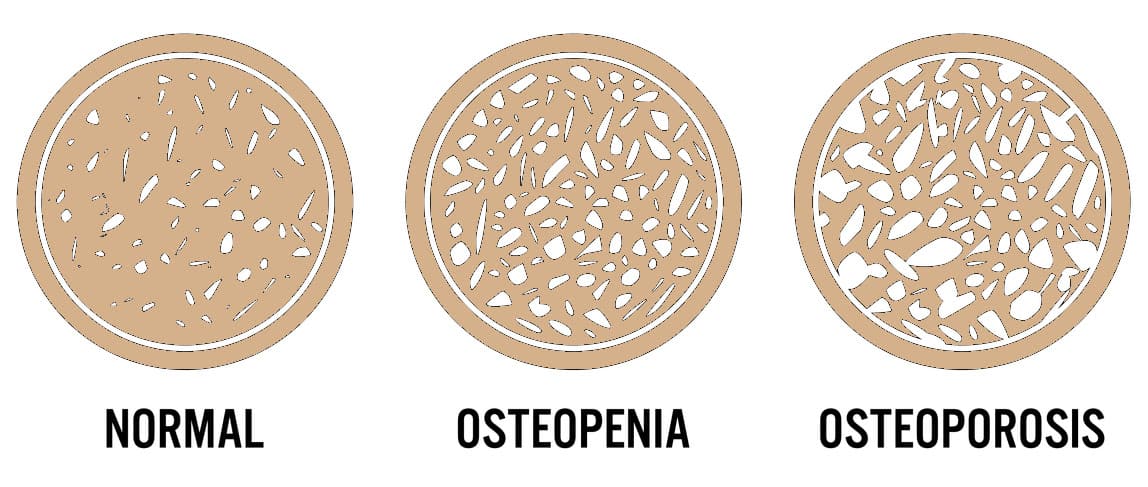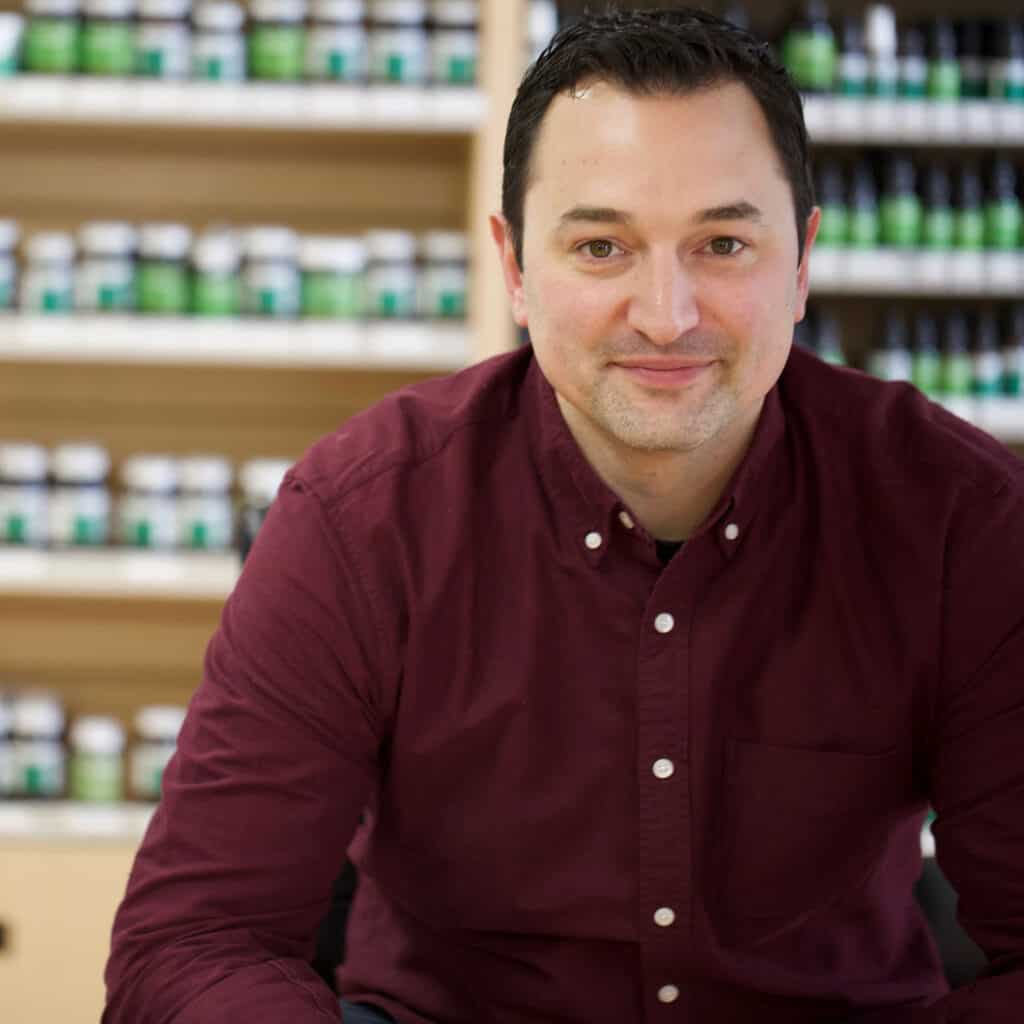Calcium made the news again recently. A meta-analysis (a study of past studies) was published in JAMA stating there is no benefit of using calcium supplementation in adults over 50.
To which we elegantly replied, “no duh.”
That’s not the whole picture; there’s more to understand before we all stop taking calcium supplements.
But yes, calcium supplementation, as most people do it, is a waste of time, and very rant-worthy. Let’s bone up on calcium!
Our Obsession With Calcium
Figuring out what calcium supplement to take seems like an American right of passage after we hit a certain age. Doctors, naturopaths, heck, even your neighbor, all recommend you get on a calcium supplement. It’s one of our Vital 5 Supplements.
This is for good reason. As we’ve often cited in our lectures, advice, and blogs, the National Institute of Health says most people get way less than the recommended daily allowance of this crucial mineral.
Like, super low amounts. Kids 9-13, girls 14-18, women 51-70, and men and women over 70 all get, on average, less than 50% of their recommended allowance.
Seeing how calcium makes up bones, and bone fractures are on the rise, it’s easy to see how the two get connected. Let’s drill into this a bit deeper, which will help us understand the meta-analysis in question.
Measuring Calcium Deficiency
How do we know that most people are deficient? We would normally take a blood test to measure a deficiency (think Vitamin D levels). Calcium in the blood accounts for only 1% of our total body calcium; the rest is stored in bones.
On top of that, calcium levels are tightly regulated by the body. This means that if your calcium numbers dip, even slightly, the bones are robbed of their calcium to keep everything normal.
This is important to understand. People with too little calcium in their diet don’t have low calcium in their blood; the body will use calcium from the bones to keep the blood levels normal (leading to our problem and discussion today).
Cases of too low (or too high) blood calcium are rare, extreme, and emergencies.
So blood tests are out. The only way we know that most people are deficient is based on reports of their diets. If you were to actually count the number of calcium-rich servings you get daily, I’d wager you’d be deficient.
Looking at real-world numbers of even the best of us is proof positive to how little we all get.
Based on our experience working with people’s diets through formal and informal consults over the years, most people get 3 full servings in a 24-hour period, putting them right at the 50% or more deficient level.
Calcium-rich food is shown in the chart below, courtesy of the NIH. A note to our vegan/vegetarian friends: you have an uphill battle as calcium in non-dairy sources is comparatively low, but most likely you are more successful at achieving RDA’s than those with the typical American diet.

The Results of Deficiency
Over the short term, low dietary calcium will contribute to bone loss. The bone structures become more hollow and more brittle. The diseases of bone density are osteopenia and osteoporosis.
Osteopenia is where your risk of fracture is slightly elevated vs normal. In osteoporosis, your risk of fracture is high. That’s as detailed as we’ll get here for the rant.
A picture’s worth 1000 words:

Do Calcium Supplements Work?
“No, not like that,” is the best, most honest answer you can get when asking this question. And it’s the one we’ve been giving for a long time now.
“Hey! You just said that if we don’t get enough, our body takes from our bones. Why wouldn’t taking more calcium prevent that and build our bones?”
Medicine isn’t black and white, even though we wish it to be. Even things seemingly related may not be, or those relationships are more complicated than common logic would allow for.
Let’s get visual. It will help, I swear. This is the relationship we are discussing:

Notice that there is no line connecting calcium and fractures. That’s why the advice of “throw a ton of calcium supplements at it,” is incorrect.
People are told to take calcium supplements to prevent fractures. That thinking and advice lacks an understanding of the above relationship. In reality, “building bones” is a stepwise process, and each step has many variables.
The true way to look at the relationship between calcium and fractures in adults is this:
INCREASING YOUR DIETARY CALCIUM WILL ONLY PREVENT BONE DENSITY LOSS. HAVING A “HEALTHY” BONE DENSITY WILL DECREASE FRACTURE RISK.
If we understand the issues at each step, then we can understand why the meta-analysis showed calcium doesn’t work.
Calcium Does Not Build Bones
It seems like a nit-picky/semantic thing to harp on, but this is the crux of understanding all of this. Biologically, it is clear, but it has gotten lost in translation—even with practitioners.
This all goes back to understanding the regulation of blood calcium. If there is too little calcium in your blood (because your dietary intake is low), your body will “rob” your bones of the calcium that is stored there. Over time, it leads to a weakening of the bones.
If dietary calcium is adequate, your bones will be left alone. If your calcium levels get too high, it won’t make bones more dense, it will simply get tossed out via urine or feces.
I know we Americans think more is better, but it is not the case with calcium. In fact, as we’ll discuss later, it can be a big problem. Nonetheless, it is important that we have a constant supply of calcium to prevent loss of bone density.
Did you say you want an analogy? ‘Cause I’ve got an analogy…. Introducing the Carpenter Analogy for Bones!
I think about building bones like building a house. Looking to calcium to build bones is inherently wrong. Saying calcium builds bones is like saying 2×4’s build houses.
Calcium is a building block, but it only sits in a pile like freshly delivered lumber without help from our body. Good analogy, right?
The initial plans of the house show how big and strong the house will be. Our genetics, including race and gender, are the primary factors for how strong our bones will be. We can influence this positively, however, during initial construction.
During this initial construction phase, we have to make sure we have all the building blocks readily available. We typically do a good job of this as parents.
Babies get lots of milk. Young kids are encouraged to have bone building diets. The thing is, peak bone mass happens at age 30. Bone building operations should still be in FULL SWING until at least 30 years of age, but it rarely is.
Besides calcium intake, exercise and minimizing smoking and alcohol are crucial to ensure the initial construction phase is done to its best.
Ensuring peak bone mass BEFORE the age of 30 is the single greatest thing to reduce the risk of fractures later in life. Not which calcium supplement you take.
Now imagine a lifetime in this house. You’ll do some remodelling. You’ll put on additions. You’ll redo a wall here or there.
We have carpenters that specialize in deconstruction and some that specialize in construction. What if the deconstructors work harder than the constructors? We have a real problem, right?
A low peak bone mass is the first major risk for fracture. The second is when the constructors and deconstructors don’t work together.
In women, we call this menopause. No joking here— estrogen is like the foreman that tells the deconstruction crew to slow down. That guy is completely off the job after menopause, and the remodeling favors taking down the walls and supports without equally rebuilding them.
Understand this: no level of calcium will build bones after menopause. It’s impossible to overcome the losses occurring. At best, adequate calcium levels will prevent further loss (the kind that happens to keep blood calcium levels normal).
The Only Thing That Builds Bones In Adults
I’ll make this brief, but it’s important. The only thing that will build bones dramatically are the prescription osteoporosis meds.
They are not perfect. They have liabilities. They work, and, in my opinion, they are victims of propaganda from the natural products industry.
The truth is, fractures are serious. It’s estimated 1 in 3 women and 1 in 12 men will have a hip fracture in their lives, and 86% of sufferers are over 65.
What’s worse, the death rate inside 1 year after a hip fracture is between 14 and 58%. That risk is real. That risk is high.
The consequences of fracture are serious and WAY worse than any risk (fake or real) of bone-building meds.
Bone building meds are not the demons they are made out to be. Speak with an expert on which one is right. There are multiple options.
Remember, to best care for ourselves, it is crucial to walk the middle path using the best data we have and check our preconceived notions at the door.
Understanding how our bones work and what calcium REALLY does will help you make better decisions about calcium supplements and have more realistic expectations of their benefit.
Calcium ingested when we are young WILL ensure we reach peak bone mass. After 30, calcium may not be increasing our bone density, but it is still essential to ensure the body has adequate amounts of calcium at all times.
What the JAMA Analysis Shows
This new meta-analysis isn’t really new. There have been many such analyses looking at past studies to determine the impact of calcium on bone density.
This one, like others before it, show that there seems to be no benefit to using calcium supplements. Any gains in bone density are small and don’t last more than a year.
We need to change our perspective a bit. Our expectation that calcium builds bone must be discarded. Instead, if we intend to study calcium’s effects, we should be asking, “What form of calcium is best at maintaining bone density the longest?”
In general, calcium trials are small and short. They use different forms and doses of calcium. Trying to weave them all together to get one coherent picture via a meta-analysis is difficult, but doable.
When you do, you see something very interesting.
Traditional forms of calcium supplementation (calcium carbonate and citrate) are often associated with the worst of the results.
Other chelates of calcium, or even a special complex called MCHA, holds bone density the longest or is associated with a slight and sustained bump in bone density.
Even in pharmacy school, we were told calcium builds bones. When looking at the real data, it is pretty clear that the calcium forms that people were using did nothing for them.
It was that realization that changed how I recommended calcium to people. From that point on, for me, it was about just slowing bone loss with the right forms of calcium.
Choosing the Right Calcium
The Many Forms of Calcium
To understand calcium, we have to understand the compound itself and what all the options are.
Since calcium is a mineral, the form matters. Calcium doesn’t exist freely in nature, it’s always bound to something else. Here is a brief list of the most common forms of calcium and our opinions on them, lightning round style:
Calcium Carbonate: This is the cheapest and most used form of calcium. Calcium carbonate literally comes from rocks or sea shells (oyster shell calcium). Calcium carbonate is the main compound found in sidewalk chalk. And we ingest it with a smile, right?
The sources are pretty gross, but here’s something interesting. The active ingredient in TUMS, the antacid, is calcium carbonate. Calcium carbonate neutralizes stomach acid and prevents heartburn symptoms.
The thing is, calcium carbonate needs an acidic environment to be absorbed. Calcium carbonate is its own worst enemy. It makes its own absorption poor!
It should be noted that magic forms of calcium like “Algae calcium” is simply calcium carbonate. Because the supplement industry are liars and charlatans.
Calcium Citrate: Calcium citrate is better than calcium carbonate, but it’s still not that great. It doesn’t require an acid environment, so it’s good from that standpoint.
Still, it’s not very bioavailable and causes side effects and irritation. Like carbonate, this form does not help bone density in most studies.
Calcium Chelates (Gluconate, Phosphate, Malate): These are well absorbed calcium products with very minimal side effects. The downside: they are VERY low dose, so you have to take lots of capsules – 8-10 are not uncommon!
Calcium MCHA (Microcrystalline Hydroxyapatite): Calcium MCHA is how our body stores bone. This is a whole complex from bones that has calcium, proteins, minerals, and other components found in bones.
The absorption is good and has little GI irritation. This is the only form that consistently slows bone density loss. It is more costly than calcium carbonate. This is the form we recommend the most.
The Right Dose of Calcium
If someone chooses to use supplements (with or without regard to the evidence supporting its use), my job is to provide the cleanest product, in the best form, at the proper doses.
I think people use too much calcium. The chart below has the RDAs based on age:


According to the chart, a female over 50 should be getting 1,200 mg daily. In my experience, doses are much higher. When people report what types of calcium they are taking and at what amounts, I typically hear 500mg three times daily or 600mg twice daily.
In both of these anecdotes, the women are meeting or exceeding the RDA with supplements alone. What about their diets?
If they were in the average, they were already receiving about 500mg daily. This means some women could have been taking almost double what they need in a day.
When we dose calcium, we need to consider our dietary intake.The doses we recommend are closer to 800mg daily for most people over 50, as they are probably getting at least 2-400mg from their diet.
We like products that yield only about 300mg per capsule. This allows more customization. If you eat yogurt, take 1 less capsule, etc.
Calcium Supplement Complications
Over the past 10-20 years, we’ve accumulated data on the effectiveness of calcium for bone density. Along with that is a growing list of long-term side effects and complications from calcium supplementation, especially poorly absorbed forms and high doses.
These are real and not frequently discussed by the “experts” out there.
Here are a few examples:
- Kidney stones (2)
- Cholesterol and artery thickness (3)
- Coronary artery calcification and heart disease (4)
- Death associated with heart disease (5)
To do things right, pick the right form of calcium first. Then, consult the RDA chart. Thankfully, the numbers don’t change much so it’s easy to remember your RDA! Then figure out, on average, what you ingest in calcium-rich foods using the first chart I shared today.
Subtract your RDA from what your average dietary intake is, and there’s your dose of calcium.
Also note, our bodies can really only handle about 600mg of calciumat a time. If we ingest more, it ends up undigested and stays in the gut.
Calcium in the gut causes constipation. As an aside, that’s why poorer forms of calcium such as carbonate or citrate cause constipation—most of it is unabsorbed. Split your doses up throughout the day.
When done right, the biggest problem with calcium is that you have to take a bunch of big capsules a couple times a day. When done wrong, you do all that AND you get side effects like GI irritation or constipation, and a risk of long-term side effects like calcification of soft tissue. I think the choice is easy!
AN IMPORTANT FINAL NOTE: If you haven’t read it yet, check out our info on Strontium For Bones. Avoid supplements with strontium! They will make your bones look stronger than they actually are.
A Strong Foundation
“The best time to plant a tree was 20 years ago. The second best time is now.”
You may not be able to improve your own peak bone mass at this point in your life. Maybe you didn’t plant your tree, but you can encourage young people (especially young women) in your life to plant their trees.
The greatest gift you can give is the encouragement to have a bone-building mindset beginning at a young age.
All is not lost, though. What you can do for yourself now is implement a better bone building strategy. Support and keep the bone mass you have with real, healthy choices. Here’s how you can accomplish this:
Ensure you are meeting RDAs for calcium intake. Do this via diet or the proper forms and right doses of calcium supplements.
Exercise regularly, especially weight bearing exercise.
Don’t be afraid of the bone building medicines. Embrace them as a tool, understanding their benefits GREATLY outweighs their risks.
Calcium – Another Misrepresented Supplement
Shortly, we’ll send a newsletter out about the other minerals and compounds used for bone health in many supplements. I just didn’t want you to have to read a 40 page dissertation here on calcium combination supplements!
All in all, we fully support the results of the meta-analysis. Calcium supplements, as most people take them, are too much of the wrong thing.
At best, it’s a huge waste of money. At worst, people can get hurt by calcium. Calcium will not build bones as many believe, and “experts” promote. Instead, the right doses and the right forms of calcium will be a crucial, but smaller part of a lifelong, bone-building plan.
And thankfully, because you are a Woodstock Vitamins customer, you are ahead of the curve!
Our Calcium Supplements are Vitality Approved, so you can be sure that you’re getting quality products: pure, potent, and consistent batch to batch.

Neal Smoller, PharmD
Owner, Pharmacist, Big Mouth



